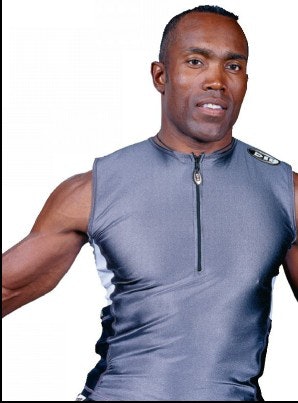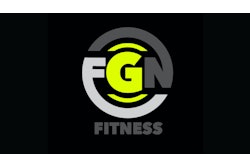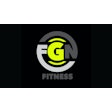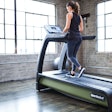As Athletes Seek Workouts That Mimic Movements In Their Chosen Sports, Many Fitness Equipment Manufacturers Are Discovering New Market Niches

Once upon a time, athletes lifted weights to strengthen their muscles and used cardiovascular machines to strengthen their hearts. And, save for a little experimentation here and there on the part of creative personal trainers, there usually wasn't much variation on that theme.
Today it's a different story. As the fitness industry has reached new levels of sophistication, more personal trainers than ever now recognize the benefits of sport-specific training, acknowledging the fact that a football player and a track and field athlete can both benefit from using the same piece of equipment - albeit in different ways. Of particular emphasis are cable-assisted weight machines that have been around forever but are now enjoying a second (or third or fourth) wind by better-educated trainers looking to spice up their clients' workouts by inviting them to train at any resistance and at any speed using any angle and any path of motion. User movements run the gamut from side to side, back and forth, up, down and around. And if that kind of training helps athletes knock a tenth of a second off their time in the 40-yard dash, count them among the converted.
We are in the midst of a functional-training renaissance. Or so says Roy Simonson. "We got so hung up during the '70s, '80s and '90s on just putting people in the gym and having them focus on fixed, isolated and stabilized movements," says the chief executive officer of FreeMotion Fitness, which in 1999 became the first equipment maker to develop a full line of selectorized strength-training machines using cables to simulate human movement patterns. "I don't know how many times you can just grab a bar. If you're a bodybuilder, God bless you. But what about the rest of us? I can't think of a single person who wouldn't benefit from some component of functional training."
Right now, the primary users of equipment designed for sport-specific training are at the extreme ends of the athletic spectrum: rehabilitation patients and elite athletes. "The person in rehab and the world-class athlete are on the same continuum," says Greg Highsmith, senior business director for Life Fitness' strength products. "We all are. We all have to be able to function without the artificial stabilizers that are created in functional strength training exercises."
Perhaps that's why health clubs, recreation centers and other mainstream facilities are also embracing functional training equipment. "What I'm noticing is a major paradigm shift in the fitness industry," says Bob Piane, chief executive officer of Vortex Fitness Equipment, which makes an all-in-one, cable-based functional strength-training unit. "Techniques are moving away from the isolation of muscle training and into the integration of muscle training. For example, a wrestler needs big biceps, but he also needs to be able to pull down his opponent and jam his knee into the guy. Isolated training won't help with that. But integrated training will help that wrestler destroy the other person. What's happening now is a big change."
It certainly is. And while there's debate within the ranks of fitness equipment manufacturers about how recently this change has evolved - some say over the last six months, others say over the last six years - there's little argument that sport-specific training (particularly in the strength realm) has emerged as the fitness industry's new market niche.
From cables and such low-tech devices as resistance bands and wobble boards to more complex pieces of machinery - a treadmill that tethers the user and forces him or her to be the motor, a plyometrics machine that users operate from a horizontal position - equipment manufacturers are creating ways to meet the demands of a changing marketplace.
Granted, not every company is involved. ("We're still working with that big group of people who don't really even know how to use our existing equipment," says one manufacturer's spokesperson.) But enough major equipment makers have taken notice and introduced individual machines or entire new lines of functional training pieces targeting both rehab clinics and performance-enhancement centers. Plus, dozens of smaller companies are entering the marketplace with devices they claim athletes have been waiting for all their lives.
"A lot of these niche products may be very viable in particular market areas," says Wes Brown, strength products manager in Nautilus' commercial division and an advocate of functional training only when it's part of a comprehensive fitness program. "It's good for trainers to be well-educated so they can do sport-specific training. But if they don't have a good foundation for training the hips, legs, back, shoulders, chest, arms, waist and neck, they're just spitting in the wind. Most strength and conditioning coaches in the pros typically agree that not many things done in the weight room outside of basic training will translate to the field. But people still buy into sport-specific training because it will give them a possible edge over their competitors."
Gaining an edge over his competitors was Simonson's plan when he founded Ground Zero Design four years ago. (The company's name was changed to FreeMotion Fitness in the wake of 9/11.) While working for two other fitness equipment manufacturers, he recognized that the original concept of using variable-resistance weight machines pioneered by Nautilus founder Arthur Jones back in 1970 could be improved upon.
Enter FreeMotion's line of selectorized cable-based equipment replicating such natural movements as pushing, pulling, twisting, lunging and squatting. "Initially, the competition found what I was doing humorous," Simonson says. "Then they saw I was starting to get some business and eventually admitted that this concept had something going for it."
Personal trainers took notice, too. Rather than simply serving as rep counters and cheerleaders for high-end athletes firmly rooted in their individual programs, they could now easily integrate variety and flexibility into workout routines.
Other companies soon developed their own versions of functional strength-training equipment. Life Fitness, for example, launched its Dual Adjustable Pulley System in 2000 - now part of the company's Cable Motion Series of strength-training products, which last fall expanded to a total of seven units. Featuring two weight stacks of 190 pounds each and two adjustable pulleys, the Dual Adjustable Pulley System is similar to a cable crossover machine and has a resistance ratio of 1:2, meaning that when the pin is set at 40 pounds on the weight stack, the actual resistance is one-half the total weight, or 20 pounds. The system also features an optional 1:4 resistance ratio. This allows for even lighter initial resistance for rehab patients and makes the stack travel a shorter distance, reducing inertia and permitting high-speed movements critical to sport-specific training.
While functional training equipment from FreeMotion and Life Fitness is making inroads into the health club market, manufacturer Keiser last year created a pair of new cable machines within its Infinity Series specifically intended for rehab and personal training environments. The Functional Trainer comes equipped with two adjustable arms that accommodate all high/low training positions and increase weight loads by one-pound increments without shock-loading muscles and joints. The other new unit, the Triple Trainer, wraps three Functional Trainers into one freestanding unit.
The Infinity Series' target user group notwithstanding, Keiser is banking on the trickle-down theory to eventually attract personal trainers at the health-club level who will begin incorporating the cable machines into mainstream facilities. "One health-club chain has more buying potential than all of the teams in pro sports," says Darrin Pelkey, Keiser's vice president of sales and marketing.
But it is all those teams in pro sports that Nautilus is targeting with the company's year-old XP-Load line of weight-training equipment, which is similar to Hammer Strength's Jammer line. Both boast a full range of movements with converging and diverging arcs of motion. Nautilus also markets the Freedom Trainer, a selectorized pulley system with user-defined paths of motion that has the same 1:4 resistance ratio as Life Fitness' Dual Adjustable Pulley System.
Meanwhile, Vortex - after a high-profile product introduction in March 2001 - laid low after 9/11 and decided to refine the cable-based stand-alone unit now known as the Vortex Pro Sports Trainer Total Body System II. That piece of equipment helps users perform exercises that allow the body to move in a countless number of angles (each one referred to by Piane as a "vector") using 360-degree capabilities. A less complex unit designed specifically for fitness centers is expected to be available later this year.
"I thought if I could figure out a way to stand in one place and train in infinite directions, I would revolutionize sports training," Piane says. "I'm anxious for the day when strength coaches don't just ask how much you can bench press, squat, and clean and jerk, but also how much wood-chopping pull you have from this vector to that vector."
Smaller specialty companies, too, have invested in the sport-specific strength-training market - from VersaClimber's VersaPulley (a high-low pulley machine that allows users to perform multijoint and multiplane exercises with variable speeds and force) to the Swedish-designed Agaton Fitness System (which allows for concentric and eccentric training employing variable independent loads for leg and bench presses, creating a heavier load on the return movement).
Among the simplest of sport-specific training products recently introduced to fitness facilities are detachable cable-machine grips, such as those available from Multi-Grip Handles. The bi-directional curves of the ergonomically designed color-coded handles - which each rotate 360 degrees and attach to any cable-based machine - target different muscle groups and, the company says, reduce stress on the wrists and other joints based simply on the way a user holds them.
Created in 1996 by Jim Davis (a former bodybuilder) to use while he was suffering from arthritis, the handles have only recently begun to be marketed to pro teams, personal trainers at performance-enhancement centers and rehab specialists. But mainstream health clubs have also begun using the handles, posting signs at the front desk offering free 15-minute introductory sessions and then pitching a multiple-week training program incorporating the handles.
At least two major equipment manufacturers recently inked deals to make Multi-Grip Handles standard on their cable-based machines, according to company chairman and chief executive officer Jaeson Cayne.
Strength-training products aren't the only fitness products getting sport-specific these days. Woodway USA recently introduced The Force, a stationary and programmable "sport loading" platform for speed training and power. The system works by tethering the user to keep him or her in place on the tread belt while he or she becomes the drive mechanism for the track assembly. The output forces generated by the user become the limiting factor in this type of training, not the top motorized speed of the treadmill. Sport-specific training is accomplished by adding more resistance or load (up to 150 pounds) via the braking mechanism.
Another treadmill-based product is Cascade Fitness Technologies' Quad Mill, which uses energy-absorption to promote eccentrically biased conditioning, used to strengthen muscles and build endurance and shock absorption. Users step on the unit's platform, select a workout profile from among five preset options and then begin exercising. Because the initial goal of the machine is to keep the legs soft, users feel a wave-like motion on the platform as it warms up their legs, buttocks and lower back. Soon, a full-conditioning fast workout ensues as the platform ramps up and down several times at predetermined intervals.
Like the Quad Mill, the Trazer - a virtual-reality exercise developed by Trazer Technologies Inc. - is found only in a limited number of training facilities at this time. That is gradually changing, though. The Trazer allows users to serve as a joystick and to control interactive video action by employing full-body aerobic movements. Exercisers move with the action on the screen while being tracked in real time by optical technology. Participants have complete freedom of movement, which assists in balance and agility training.
At least one product, the Shuttle ® MVP, began life as a cardiovascular training tool - in fact, the impetus for the product came back in the 1960s as a means for astronauts to increase their cardiovascular levels at zero gravity. The concept has since morphed into a plyometrics training tool. When Gary Graham left his job as an aerospace engineer with Boeing in the mid-'80s and was looking for a new line of work, he recalled the aborted cardio concept and decided to update it.
He founded Shuttle Systems by Contemporary Design Co. and through the process of trial and error eventually created the Shuttle MVP, a product that looks similar to a Pilates machine and mitigates the effect of body weight during exercises by positioning users horizontally on a carriage that glides along an elongated rail system. A large padded platform for the feet is mounted at a right angle to the rails, and latex cords allow up to 500 pounds of resistance. The horizontal position of the user mitigates gravity, significantly reducing the impact to the joints and spine. Along with the conventional strengthening activities of a leg press, the elasticity of the cords and the long rail system allow users to repeatedly jump away from and land on the padded platform, building strength, speed, explosiveness, endurance and core stability, the company says.
The product's initial target group was the medical market, where Graham envisioned the product being used in cardiac-rehab situations. Personal trainers pledging allegiance to plyometrics, however, turned the unit into a running and jumping simulator. In an ironic twist, NASA astronauts now use the Shuttle MVP as a training tool. (For the rehab market, Shuttle Systems created the Shuttle ® 2000-1, a similar machine.)
"This was definitely a market-driven thing," says Heather Graham, vice president of Shuttle Systems, who claims the idea of using the product for plyometrics never entered her mind. "We had no idea what manufacturers out there were doing. We just had two pieces of pipe, a piece of plywood and some string. From there, we somehow got it to the marketplace."
The Shuttle MVP's evolution is indicative of the functional-training equipment industry's experimental nature. "What's exciting is that trainers are constantly pushing the limits. They're constantly finding ways to use the machines in ways we never thought of," Simonson says, citing as examples stories of athletes using FreeMotion equipment while balanced on a wobble board or attaching a hockey stick or tennis racquet to the equipment's grips for cable-resisted, sport-specific training motions. "The single biggest question is how progressive and willing everybody involved in a facility's operation is to advance the state of the art. It's all about trying new things and thinking a little differently. Cable-based machines are like dumbbells and free weights, in that you're only limited by your imagination."
The same can be said about the manufacturing side of the industry. The design and development of functional-training equipment leaves lots more room for experimentation than does the creative process for traditional equipment. And by listening to stories about intriguing ways in which trainers and athletes have put their products to use - and by visiting facilities to observe firsthand how those products are being incorporated into training routines - research and development teams can continue creating products that fill even more-specific niches. "I've been doing nothing but listening, listening and listening," Piane says. "I've got 38 new improvements going into my machines."
"There's a tendency in any industry, when people sense a niche, to try to turn something into something it isn't," says Jim Chasteen, Woodway USA's national sales and marketing manager. "To take a conventional treadmill, give it a maximum speed of 15 miles per hour and call it a performance training piece when it's not built any differently than any other conventional treadmill is nothing new. We're still very much in the infancy of the sport-specific performance market, and we can't afford to lose track of our core users. We're not going to quit our day jobs because of the success of The Force."
That said, this particular segment of the industry is enjoying unprecedented optimism. "Right now, there's this functional-training buzz," Highsmith says. "That's a trend, and like any other trend, it'll probably go up and down. But this kind of equipment is always going to be something we're thinking about, because it's so much fun to think about."




































